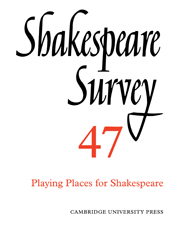Book contents
- Frontmatter
- Shakespeare Played Small: Three Speculations about the Body
- The Architecture of the Fortune Playhouse
- The Bare Island
- ‘How Chances it they Travel?’ Provincial Touring, Playing Places, and the King’s Men
- Writing for the Metropolis: Illegitimate Performances of Shakespeare in Early Nineteenth-Century London
- The Perishable Body of the Unpoetic: A. C. Bradley Performs Othello
- Playing Places for Shakespeare: The Maddermarket Theatre, Norwich
- ‘A Fairly Average Sort of Place’: Shakespeare in Northampton, 1927–1987
- The Living Monument: Self and Stage in the Criticism and Scholarship of M. C. Bradbrook
- Stratford Stages: Interviews with Michael Reardon and Tim Furby, and Sam Mendes
- Dis-Covering the Female Body: Erotic Exploration in Elizabethan Poetry
- Theseus’ Shadows in A Midsummer Night’s Dream
- ‘Time for Such a Word’: Verbal Echoing in Macbeth
- Shakespeare’s Knowledge of Italian
- Tamburline and Edward Alleyn’s Ring
- Shakespeare Performances in England, 1992–1993
- Professional Shakespeare Productions in the British Isles, January-December 1992
- The Year's Contributions to Shakespeare Studies 1 Critical Studies
- 2 Shakespeare’s Life, Times, and Stage
- 3 Editions and Textual Studies
- Books Received
- Index
Playing Places for Shakespeare: The Maddermarket Theatre, Norwich
Published online by Cambridge University Press: 28 March 2007
- Frontmatter
- Shakespeare Played Small: Three Speculations about the Body
- The Architecture of the Fortune Playhouse
- The Bare Island
- ‘How Chances it they Travel?’ Provincial Touring, Playing Places, and the King’s Men
- Writing for the Metropolis: Illegitimate Performances of Shakespeare in Early Nineteenth-Century London
- The Perishable Body of the Unpoetic: A. C. Bradley Performs Othello
- Playing Places for Shakespeare: The Maddermarket Theatre, Norwich
- ‘A Fairly Average Sort of Place’: Shakespeare in Northampton, 1927–1987
- The Living Monument: Self and Stage in the Criticism and Scholarship of M. C. Bradbrook
- Stratford Stages: Interviews with Michael Reardon and Tim Furby, and Sam Mendes
- Dis-Covering the Female Body: Erotic Exploration in Elizabethan Poetry
- Theseus’ Shadows in A Midsummer Night’s Dream
- ‘Time for Such a Word’: Verbal Echoing in Macbeth
- Shakespeare’s Knowledge of Italian
- Tamburline and Edward Alleyn’s Ring
- Shakespeare Performances in England, 1992–1993
- Professional Shakespeare Productions in the British Isles, January-December 1992
- The Year's Contributions to Shakespeare Studies 1 Critical Studies
- 2 Shakespeare’s Life, Times, and Stage
- 3 Editions and Textual Studies
- Books Received
- Index
Summary
In 1599, while the first Globe playhouse began opening its doors to the London public, Shakespeare’s fellow actor, Will Kemp, set out on his ‘Nine-days Wonder’ morris-dance to what was then England’s second most important city, Norwich. Fittingly, it was near the spot where Kemp ended his dance in Norwich that the Maddermarket Theatre, the first permanent Elizabethan-style theatre to be built in modern times, was opened on 26 September 1921. The Maddermarket Theatre was built by W. Nugent Monck, who was arguably the most accomplished and influential of the generation of directors who passed on the legacy of William Poel. By 1933, when Monck completed the Shakespeare canon – making him the first producer known to have done so – he was one of the most highly regarded Shakespearian producers in England and his Maddermarket Theatre among the best-known ‘Little Theatres’ in the world. Today, with the International Shakespeare Globe Centre building its new Globe near the site of the 1599 original, it seems especially appropriate to revisit the Maddermarket experiment and the work Nugent Monck did there.
Nugent Monck was twenty-four when he joined William Poel's highly influential revival of the medieval classic, Everyman, in 1902. Monck played the part of Fellowship and for the next ten years he acted in Poel's productions and served regularly as his stage manager. Monck was able to observe Poel's methods in meticulous detail and seems to have grasped both the great potential and the serious limitations of Poel's approach.
- Type
- Chapter
- Information
- Shakespeare Survey , pp. 81 - 90Publisher: Cambridge University PressPrint publication year: 1994
- 1
- Cited by

